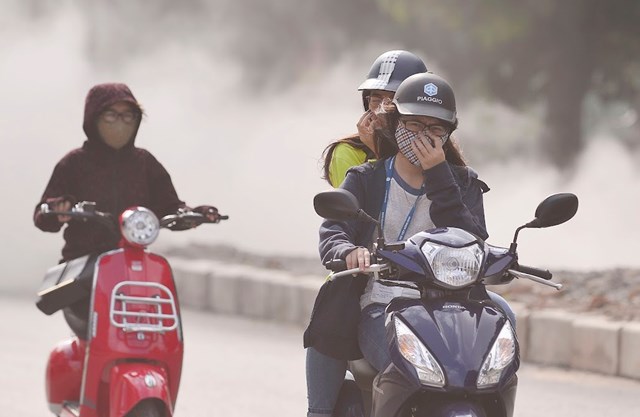
High amount of micro dust causes a lot of disease burden
Much higher than the standard threshold
According to the Vietnam Center for Environmental Monitoring, the average concentration of PM2.5 and PM10 fine dust in the air in Hanoi and Ho Chi Minh City exceeds the standards of the World Health Organization and tends to remain at high thresholds. , causing harm to the environment and human health at an alarming rate.
According to Assoc. Prof. Dr. Nguyen Thi Nhat Thanh (University of Technology), the annual average concentration of PM2.5 dust in districts, towns and cities ranges from 28.15 μg/m3 to 39.4 μg/m3. Inner urban districts such as Dong Da, Ba Dinh, Hai Ba Trung have the highest concentration of PM2.5; suburban districts such as Ba Vi, Thach That, Son Tay... have lower concentrations of PM2.5 dust. However, even when Ba Vi has the lowest PM2.5 concentration, it is still higher than the national standard threshold set by the Ministry of Natural Resources and Environment.
The amount of fine dust is high, so the burden of disease related to death and hospitalization due to exposure to PM2.5 dust in Hanoi in 2019 is not small. Specifically, the number of premature deaths due to exposure to PM2.5 dust is 2,855 cases, equivalent to about 35.5 premature deaths per 100,000 people. With a size of less than 2.5 microns, fine dust easily penetrates deep into the alveoli and blood vessels when breathing, carrying many toxins, causing respiratory and cardiovascular diseases. Therefore, with the annual increase in PM2.5 dust concentration in Hanoi, an average of 1,062 additional hospital admissions for cardiovascular disease and about 2,969 hospitalizations for respiratory disease are added each year, respectively. with 1.2% and 2.4% of the total number of hospital admissions due to these two groups in Hanoi residents.
In addition, exposure to fine dust particles can cause short-term health effects on eyes, ears, nose, throat, and lungs; long-term exposure will cause serious diseases such as chronic bronchitis, impaired lung function; increase mortality from lung cancer and heart disease, promote cirrhosis...
Where does micro dust come from?
Scientific studies over the years have shown that the main sources of fine dust, which regularly affect the air quality in Hanoi's urban areas, include traffic dust, suspended dust, fly ash from charcoal stoves and biomass burning, dust is derived from waste… But the most are still emissions from more than millions of vehicles, most of which are motorbikes. Because according to researchers, in the smoke from vehicles, there are particles in the form of particles, called primary particles, including dust and dirt caused by vehicles accelerating from the road, pavement, products of engine wear, brakes. , tires, and particles released from the exhaust pipe due to unburnt fuel such as black carbon (soot), is very toxic.
Dust concentration fluctuates hourly, daily, night may be higher than daytime, winter is always higher than summer...depending on meteorological and weather conditions. And so, Hanoi's air pollution also changes seasonally, in which the most polluted time is in winter, concentrated from September to March next year. This is because the winter meteorological conditions are favorable for the formation of heat inversion, which makes pollutants unable to be dispersed. In the summer, especially the period from May to July, Hanoi's air quality is improved due to the impact of rainy meteorological conditions.
How to reduce micro dust, protect people's health? The researchers made recommendations to policymakers that an interagency plan to respond to air pollution should be developed and implemented, including medical guidelines and health protection measures, and measures. limit emissions corresponding to air pollution levels; develop a system of air quality forecasting and warning of air pollution episodes; communication, awareness raising...
More specifically, urban planning and management agencies need to take inventory of emission sources, thereby building a database, both as a basis for urban development planning and management, and as an input. input for dispersion models in the study of the air environment.